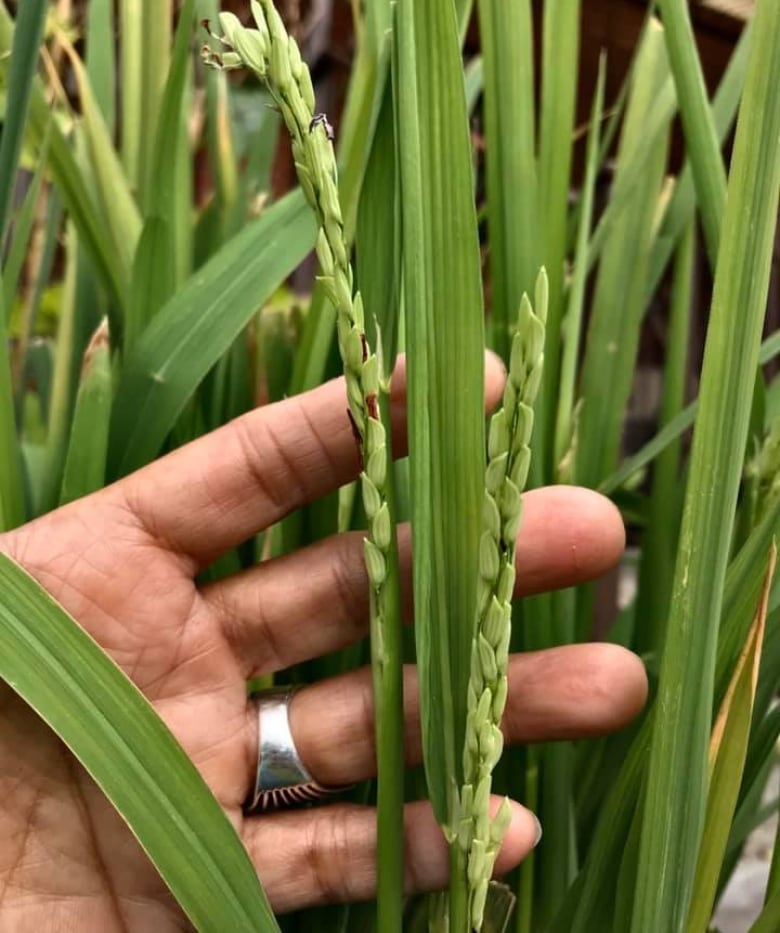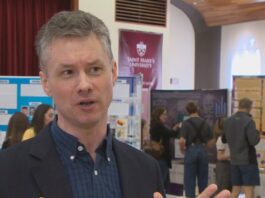
Jewel Gomes is getting ready for another growing season in her tiny Toronto backyard, home to her many experiments in agronomy. This summer, she will try to grow crops such as bitter gourd and white strawberry — plants not normally found in Canada.
“I like to experiment with vegetables or plants that are almost impossible to grow here,” she said.
Gomes studied agriculture in university in the Philippines before moving to Canada in the 1980s. Unfazed by the fact the climate here is far from tropical, Gomes has managed to grow many plants that normally need warmer weather, including rice, which she successfully produced in 2019 and displayed at events in the city.

“They were so excited. They were, like, touching, just touching this grain. They cannot believe it, rice growing in Toronto!” Gomes said of the reaction she received.
But Gomes’s backyard gardening is more than just a hobby. Experts in urban gardening say growers like Gomes can be at the forefront of helping cities mitigate — and adapt to — some of the worst impacts of climate change.
So much so that cities such as Toronto and Montreal have urban agriculture strategies to boost farming inside their city limits. The City of Mississauga, just west of Toronto, is currently working on an urban agriculture strategy as one of the pillars of its climate change action plan.
Dianne Zimmerman, Mississauga’s environment manager, says in addition to the benefits of producing food locally, including cutting down greenhouse gas emissions caused by transporting food long distances and supporting biodiversity in the city, urban gardening can also foster a sense of inclusion. A benefit that’s perhaps even more valued now as a result of the pandemic, she said.
“When we think about the multifaceted benefits of community gardens, it does create a sense of community health and well-being,” Zimmerman said. “We’ve seen a significant increase in interest of residents wanting to participate in some of those gardens as a result of COVID.”
Space to grow
Apart from private backyard gardens, urban gardening includes larger community gardens, allotment areas and building rooftops that allow people who don’t have backyards to also grow food. Ryerson University in downtown Toronto operates a rooftop farm on its engineering building that has a little under a quarter acre of growing space.
In that little space in the middle of the crowded city, the farm grows about 4,500 kilograms of food every year that supplies the university community and local chefs.
The farm has also become a lab for researchers like Tamer Almaaitah, a PhD student in civil engineering, who is studying rooftop farming’s potential for collecting stormwater runoff to reduce the risk of flooding.
“In cities, we are very vulnerable to intense rainfall, and we’ve seen in 2013 Toronto experienced a massive rainstorm,” Almaaitah said. “The more we have rooftop farms, the more we can retain water on those rooftops and we are actually reducing the pressure on the main sewer system.”
In Toronto, a bylaw requires large new buildings to make sure a certain amount of their rooftop is a green space, meaning covered by a growing medium and vegetation that’s been planted over a waterproofing membrane. But it does not necessarily require the rooftop to be a food-producing garden. While the city now has hundreds of green roofs, only a handful are crop-growing gardens.
Almaaitah and other researchers at Ryerson hope to show how growing water-intensive crops, coupled with the right growing surfaces, can maximize the ability of roofs to absorb stormwater and prevent flooding. The university is currently building its second rooftop farm, atop a residence building, to expand food production and research opportunities.
Sharing seeds and food
While her backyard is much too small to produce a significant amount of food, Gomes has connected with a larger community of food growers interested in trying new crops and sharing seeds. Gomes posts her experiments on her popular Facebook page and has received requests for seeds from as far away as Germany.
More recently, she traded seeds with farmers at Six Nations of the Grand River in southern Ontario. In exchange for rainbow corn seeds, she received rare blue corn, which she plans to try to grow this season.
WATCH | Urban gardeners experiment with crops not typically grown in Canada:
Climate change is allowing urban gardeners to grow exotic plants — which can help prepare cities for some of the worst impacts of a warming world. 1:59
“It’s really amazed me, because some people appreciate what we are growing here. They are looking for the seeds, they are reaching out for the seeds,” she said.
The seed exchanges help get more people involved in urban gardening, which, if given the right amount of space, can produce a significant amount of local food. A 2010 study by researchers at York University suggested Toronto has the land and rooftop space available within its boundaries to produce 10 per cent of the fresh vegetables consumed in the city.

Growing significant amounts of food within the city is not necessarily a new concept. Karen Landman, a professor at the University of Guelph who researches urbangardening, says agriculture used to be a part of North American cities before being gradually zoned out of urban areas after the First World War.
“It’s actually a very old practice,” she said. “There is a lot of land where it could be turned into food production. And if we really had to, we could produce a lot of food. There are other cities in the world where urban agriculture is the primary source of food for many people.”
Landman says experimenters like Gomes can actually influence the larger agriculture industry as well. Okra, for example, is a vegetable that is now grown commercially in Canada, following the lead of urban gardeners in Ontario who first tried to produce it. Their success led to a university research centre studying the process more closely.
Appreciation for green spaces
Rhonda Teitel-Payne, a co-ordinator with Toronto Urban Growers, a local advocacy group, says she has noticed a growth in interest in gardening among city dwellers during the pandemic.
She says people are understanding the importance of green spaces closer to home.
“One reason is that people were not feeling secure about the food system and whether they would be able to access enough food for their family, but also for their neighbours,” she said.
“So a lot of interest from people who had never grown food before. But the second piece of it is also that people were really understanding the importance of nature for our mental health and for our well-being.”

Teitel-Payne said she hopes people will continue to change the way they think about cities and their own role in greening urban spaces.
“I think people think of concrete canyons. They think of roadways and pollution. And really, that is a very large part of our experience in the urban environment,” she said.
“And so when we get to create these spaces, we’re compensating for that a little bit.”













